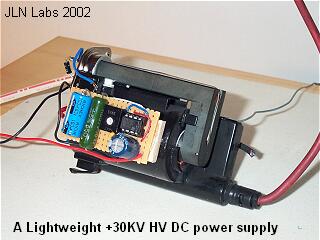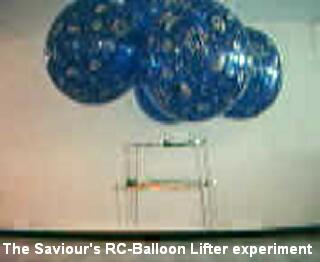
A Lightweight High
Voltage DC Power Supply
The
LW-HVPS v1.0
created on
April 4, 2002 - JLN Labs -
Last update April 17, 2002
All informations in this page are published free and
are intended for private/educational purposes and not for
commercial applications
You will find below a detailled diagram
of a compact and lightweight HV power supply ( LW-HVPS v1.0 ) for
the Lifter experiments. This diagram has been initially designed
by Saviour. A such power supply has been used successfully by
Saviour in his RC-Balloon Lifter experiment. The LW-HVPS is able to run up to 30 mn on
common rechargeable NiMh batteries ( type HR22 ).

I have build and tested myself this
power supply and it works very fine. Comparing to the previous
basic 30KV
power supply that I
have presented in this web site, the LW-HVPS is lighter, more
compact and cheapless. No HV triper is required and this use only
common components.



LW-HVPS v1.0 -
Components Listing




See the HR7839 or 1352.5003 FlyBack transformer
diagram
Technical note from Saviour ( 04-05-02
):
In the original design the transistor used was BU508D.
The difference between this and a BU508A or BU208A is
that it has a built in damper diode. If you use the 'A'
versions, then connect a fast switching TV damper diode
such as BY228 or BY448 across CE to protect the
transistor against high reverse voltages. Without this
diode the circuit may still work fine, as long as your
lifter does not arc, but better be safe.
I would prefer to use the plastic packaged (fully
isolated) transistor (lighter and insulated) however if
you have to work with the metal cased transistor make
sure you insulate the case (collector) as this is
connected to the high voltage dc supply. Note insulation
in JLN's photo.
Also, try not to leave any metal part of the circuit
unconnected. In particular, the core of the transformer
is preferable connected to the common 0v of the circuit.
Just connect a short wire from the steel spring holding
the core together, to 0v. Any unconnected metal may
charge up to hv and at any time may discharge in the form
of a spark to any part of your circuit. Also, remember
that once your circuit is not connected to ground, the 0v
is no longer at your body's potential, so it might not be
pleasant to touch anything when switched on. Same applies
to the lifter 0v.
Regards,
Saviour |

| BE CAREFUL, USE
EXTREME CAUTION !!!, this
device use High Voltage, ALWAYS
switch off the input and discharge the output to the ground through 10k/2W
resistor before touch
it. These plans are not intended for the inexperienced.
User of this document should be very carefull and
experienced in High-Voltage electronics to try anything
out ! If you do it the risk of any results is just yours.
I take no responsibility of anything that might happen. |
| ATTENTION !!!,
Faites preuve d'une extrême prudence, Vous manipulez ici de la Haute-Tension,
TOUJOURS arrêter
puis déconnecter votre alimentation ou
le moniteur et décharger la
sortie Haute Tension à travers une résistance de
10Kohms/2W avant toute manipulation.. Les
plans et les conseils présentés ici, ne sont pas
destinés à des débutants. Vous devrez procéder avec
soin et prudence et avoir l'habitude de manipuler de
la Haute-Tension avant d'envisager une telle expérience
! Si vous décider de réaliser cette expérience, ceci
est à votre propre risque et je décline toute
responsabilité en ce qui concerne les éventuels
dommages matériels ou physiques causés. |
See Also :

The
RC-Balloon Lifter experiment by Saviour
Return to the Lifters experiments page











